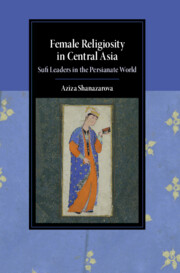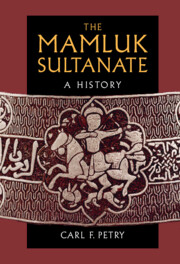68 results
Antinomianism as a way to God in nineteenth-century Java: the Suluk Lonthang between Islamic and pre-Islamic religious discourse
-
- Journal:
- Journal of the Royal Asiatic Society , First View
- Published online by Cambridge University Press:
- 20 May 2024, pp. 1-25
-
- Article
- Export citation

Female Religiosity in Central Asia
- Sufi Leaders in the Persianate World
-
- Published online:
- 25 April 2024
- Print publication:
- 02 May 2024
Sufism vs. Monism in ʿAzīz-i Nasafī's Works
-
- Journal:
- Iranian Studies ,
- Published online by Cambridge University Press:
- 04 April 2024, pp. 1-17
-
- Article
- Export citation
The Naqshbandiyya Mujaddidiyya in China
-
- Journal:
- Journal of the Royal Asiatic Society / Volume 34 / Issue 2 / April 2024
- Published online by Cambridge University Press:
- 02 April 2024, pp. 271-302
- Print publication:
- April 2024
-
- Article
-
- You have access
- Open access
- HTML
- Export citation
“All the world at the palm of the hand”: imagining history through the life of an early Afghan saint
-
- Journal:
- Bulletin of the School of Oriental and African Studies / Volume 87 / Issue 1 / February 2024
- Published online by Cambridge University Press:
- 02 February 2024, pp. 151-167
- Print publication:
- February 2024
-
- Article
-
- You have access
- Open access
- HTML
- Export citation
Crossing boundaries: reading Mirṣād al-‘Ibad in early modern China (redrawing and straddling borders)
-
- Journal:
- International Journal of Asian Studies , First View
- Published online by Cambridge University Press:
- 10 January 2024, pp. 1-13
-
- Article
-
- You have access
- Open access
- HTML
- Export citation
7 - Islam
-
- Book:
- Learning from Other Religions
- Published online:
- 30 October 2023
- Print publication:
- 16 November 2023, pp 260-309
-
- Chapter
- Export citation
Jinn and Jins: Sensuous Piety as Queer Ethics
-
- Journal:
- Cambridge Journal of Postcolonial Literary Inquiry , First View
- Published online by Cambridge University Press:
- 10 August 2023, pp. 1-25
-
- Article
-
- You have access
- Open access
- HTML
- Export citation
Shadow Performance in Iran
-
- Journal:
- Iranian Studies / Volume 56 / Issue 4 / October 2023
- Published online by Cambridge University Press:
- 08 June 2023, pp. 793-809
- Print publication:
- October 2023
-
- Article
-
- You have access
- Open access
- HTML
- Export citation
12 - Persianate Peregrinations: Elite Migration in Eurasia, from the Eleventh to Nineteenth Centuries
- from Part IV - Migration by Land
-
-
- Book:
- The Cambridge History of Global Migrations
- Published online:
- 12 May 2023
- Print publication:
- 01 June 2023, pp 240-258
-
- Chapter
- Export citation
Unearthing Rabiʿa's Grave: Placemaking, Shrines, and Contested Traditions in Balkh, Afghanistan
-
- Journal:
- International Journal of Middle East Studies / Volume 55 / Issue 1 / February 2023
- Published online by Cambridge University Press:
- 27 February 2023, pp. 1-24
- Print publication:
- February 2023
-
- Article
-
- You have access
- Open access
- HTML
- Export citation
Chapter 4 - When Does a Virtue Become a Vice?
- from Part I - Gratitude and God
-
-
- Book:
- A Theology of Gratitude
- Published online:
- 16 December 2022
- Print publication:
- 22 December 2022, pp 52-66
-
- Chapter
- Export citation
Chapter 2 - Islam and the Praxis of Gratitude
- from Part I - Gratitude and God
-
-
- Book:
- A Theology of Gratitude
- Published online:
- 16 December 2022
- Print publication:
- 22 December 2022, pp 18-37
-
- Chapter
- Export citation
And the Master Answered?: Deferrals of Authority in Contemporary Sufism in Iran
-
- Journal:
- Iranian Studies / Volume 56 / Issue 2 / April 2023
- Published online by Cambridge University Press:
- 28 October 2022, pp. 365-386
- Print publication:
- April 2023
-
- Article
-
- You have access
- Open access
- HTML
- Export citation
The Reception of Pauline Mysticism: An Ideological Critique
-
- Journal:
- New Testament Studies / Volume 68 / Issue 4 / October 2022
- Published online by Cambridge University Press:
- 08 September 2022, pp. 363-374
- Print publication:
- October 2022
-
- Article
- Export citation
Prophetic Piety, Mysticism, and Authority in Premodern Arabic Devotional Literature: al-Jazuli's Dala'il al-Khayrat (15th Century)
-
- Journal:
- International Journal of Middle East Studies / Volume 54 / Issue 3 / August 2022
- Published online by Cambridge University Press:
- 22 August 2022, pp. 462-483
- Print publication:
- August 2022
-
- Article
-
- You have access
- Open access
- HTML
- Export citation
Pilgrimage, performance, and peripatetic kingship: Akbar's journeys to Ajmer and the formation of the Mughal Empire
-
- Journal:
- Journal of the Royal Asiatic Society / Volume 33 / Issue 2 / April 2023
- Published online by Cambridge University Press:
- 04 July 2022, pp. 271-296
- Print publication:
- April 2023
-
- Article
-
- You have access
- Open access
- HTML
- Export citation
Chapter 10 - A Medieval Sufi Thecla?
- from Part II - An Act to Surpass
-
-
- Book:
- Thecla and Medieval Sainthood
- Published online:
- 06 May 2022
- Print publication:
- 26 May 2022, pp 282-317
-
- Chapter
- Export citation

The Mamluk Sultanate
- A History
-
- Published online:
- 05 May 2022
- Print publication:
- 26 May 2022
The Sufi and the Sickle: Theorizing Mystical Marxism in Rural Pakistan
-
- Journal:
- Comparative Studies in Society and History / Volume 64 / Issue 2 / April 2022
- Published online by Cambridge University Press:
- 01 April 2022, pp. 300-334
-
- Article
-
- You have access
- Open access
- HTML
- Export citation



